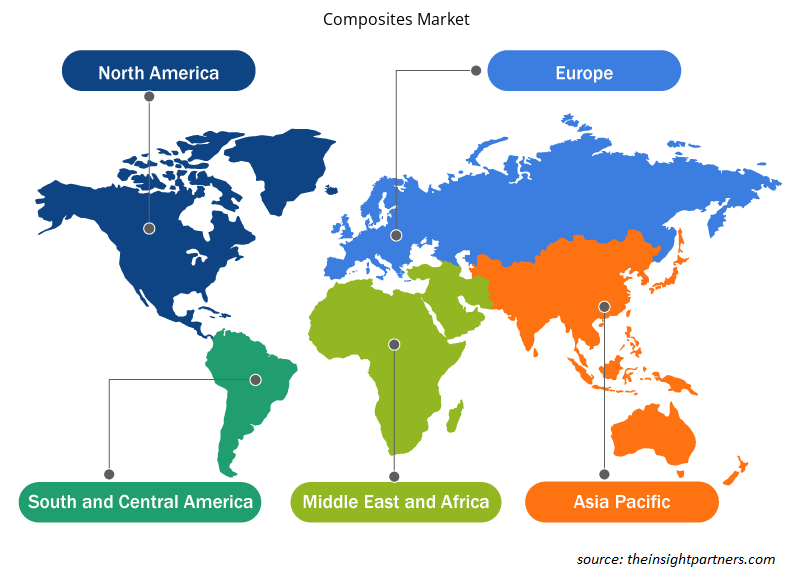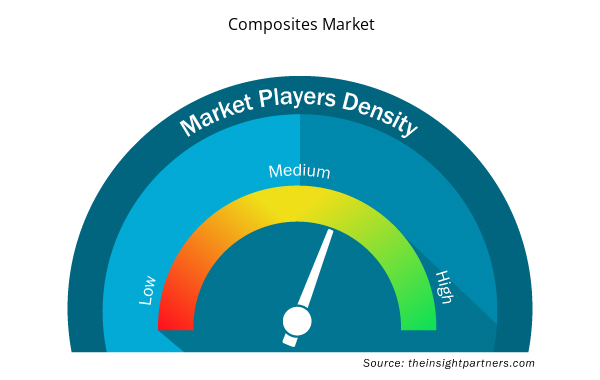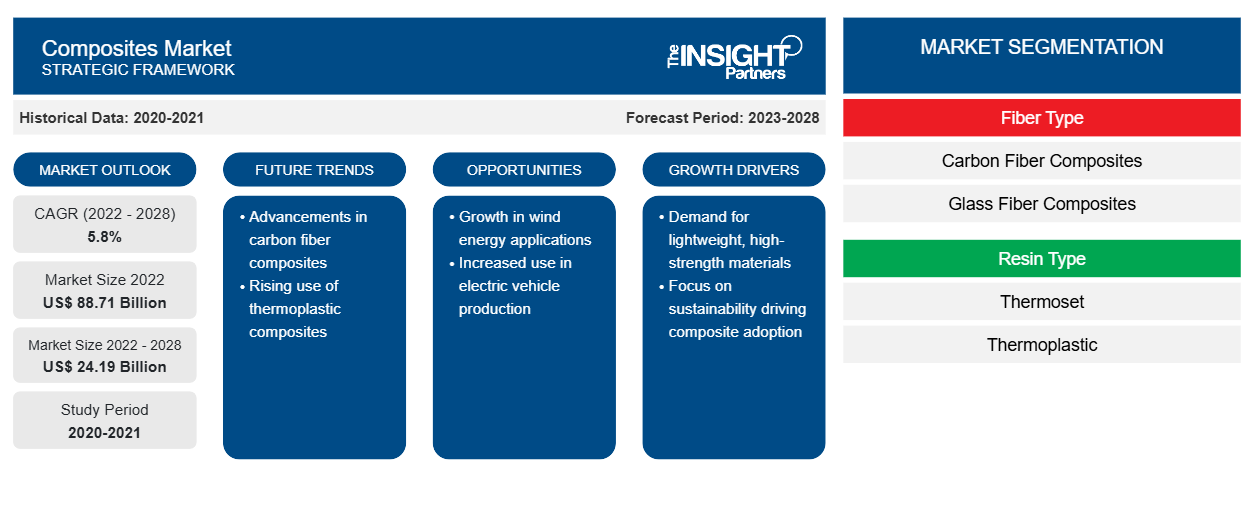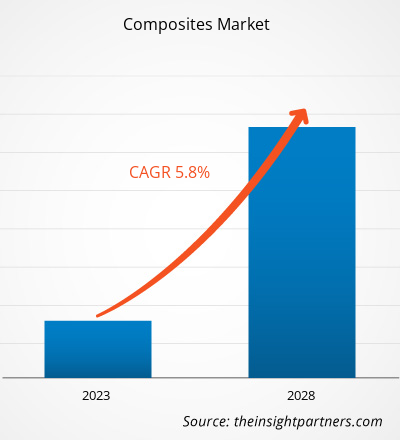من المتوقع أن ينمو حجم سوق المواد المركبة من 88،710.42 مليون دولار أمريكي في عام 2022 إلى 124،185.35 مليون دولار أمريكي بحلول عام 2028؛ ومن المتوقع أن ينمو بمعدل نمو سنوي مركب قدره 5.8٪ من عام 2022 إلى عام 2028.
تتميز المواد المركبة بخفة وزنها مقارنة بمعظم أنواع الأخشاب والمعادن. وتجعل خاصية خفة الوزن التي تتميز بها المواد المركبة استخدامها في السيارات والطائرات أمرًا مهمًا، حيث يوفر الوزن الأقل كفاءة أفضل في استهلاك الوقود. وفي الوقت الحاضر، يهتم مصممو الطائرات كثيرًا بالوزن، حيث يؤدي تقليل وزن الطائرة إلى تقليل كمية الوقود التي تحتاجها وزيادة سرعتها. وعلاوة على ذلك، تقاوم المواد المركبة التلف الناتج عن الطقس والمواد الكيميائية القاسية. ويمكن تشكيلها في أشكال معقدة بسهولة أكبر من معظم المواد الأخرى.
في عام 2022، استحوذت منطقة آسيا والمحيط الهادئ على أكبر حصة من الإيرادات في سوق المركبات العالمية . يتزايد الطلب على المركبات في منطقة آسيا والمحيط الهادئ بسبب الاستخدام المتزايد للمركبات في مختلف الصناعات النهائية مثل صناعة السيارات وطاقة الرياح والبناء والسلع الرياضية وغيرها الكثير. تعد صناعة البناء والتشييد المتنامية مساهمًا قويًا في نمو سوق المركبات في المنطقة. تشهد منطقة آسيا والمحيط الهادئ تحضرًا، جنبًا إلى جنب مع زيادة بناء المشاريع السكنية والتجارية. علاوة على ذلك، زاد دخل الفرد في المنطقة، إلى جانب تطوير المباني السكنية بأسعار معقولة. وقد أدى هذا إلى تحضر سريع في منطقة آسيا والمحيط الهادئ. دفعت السياسات الحكومية المفيدة المتعلقة بتطوير العقارات السكنية في العديد من دول المنطقة التحضر. علاوة على ذلك، تعد دول مثل الصين والهند من بين أكبر خمس دول في العالم من حيث طاقة الرياح المثبتة. تساهم كل هذه العوامل بشكل إيجابي في نمو سوق المركبات في المنطقة.
قم بتخصيص هذا التقرير ليناسب متطلباتك
ستحصل على تخصيص لأي تقرير - مجانًا - بما في ذلك أجزاء من هذا التقرير، أو تحليل على مستوى الدولة، وحزمة بيانات Excel، بالإضافة إلى الاستفادة من العروض والخصومات الرائعة للشركات الناشئة والجامعات
- احصل على أهم اتجاهات السوق الرئيسية لهذا التقرير.ستتضمن هذه العينة المجانية تحليلاً للبيانات، بدءًا من اتجاهات السوق وحتى التقديرات والتوقعات.
تأثير جائحة كوفيد-19 على سوق المركبات
كانت الصناعات مثل صناعة السيارات والفضاء والبناء والبحرية والطاقة هي المساهم الرئيسي في الطلب على المركبات. في عام 2020، اضطرت هذه الصناعات إلى إبطاء عملياتها بسبب الاضطرابات في سلسلة القيمة الناجمة عن إغلاق الحدود الوطنية والدولية. أدى نقص القوى العاملة إلى تباطؤ عمليات إنتاج وتوزيع المركبات. أدت الاضطرابات في سلسلة التوريد العالمية وإغلاق مرافق إنتاج الراتينج إلى ارتفاع حاد في أسعار المركبات. أعاقت عمليات الإغلاق التي فرضتها دول مختلفة في عام 2020 قدرة الصناعات على الحفاظ على مستويات المخزون. علاوة على ذلك، أدت التدابير الصحية وغيرها من احتياطات كوفيد-19 إلى تقليص القدرة الإنتاجية بشكل كبير، مما أدى إلى نقص في مخزون المركبات. ومع ذلك، في عام 2021، بدأ السوق العالمي في التعافي من الخسائر التي تكبدها في عام 2020 حيث أعلنت حكومات دول مختلفة عن تخفيف القيود الاجتماعية. علاوة على ذلك، ساهمت معدلات التطعيم المتزايدة في تحسين الظروف العامة في بلدان مختلفة، مما أدى إلى بيئات مواتية للتقدم الصناعي والتجاري. وفقًا للمنتدى الاقتصادي العالمي، فإن جائحة كوفيد-19 لديها القدرة على جلب الابتكارات في تصميمات المنازل ومن المتوقع أن توفر فرصًا جديدة في مجال تجديد المنازل. ومن المتوقع أن يوفر هذا العامل فرصًا مربحة لنمو سوق المواد المركبة خلال فترة التنبؤ.
رؤى السوق
تزايد الطلب على المواد خفيفة الوزن من صناعة السيارات والطيران
يفضل مصنعو السيارات استخدام المواد خفيفة الوزن في تصنيع السيارات مع ضمان السلامة والأداء. تتمتع المواد خفيفة الوزن بإمكانات ممتازة لزيادة كفاءة الوقود. يمكن أن يؤدي انخفاض وزن السيارة بنسبة 10% إلى زيادة في الاقتصاد في استهلاك الوقود بنسبة 6-8%. تتمتع المواد المتقدمة مثل مركبات ألياف الكربون بإمكانية تقليل وزن مكونات السيارات بنسبة 50-75%. يستمر تطبيق المركبات في قطاع السيارات في النمو. تتمتع المركبات البلاستيكية بخصائص صوتية وحرارية ممتازة مقارنة بالمركبات ذات الأصل غير المتجدد، مما يجعلها مثالية لأجزاء السيارة الداخلية. علاوة على ذلك، فهي مناسبة لتصنيع المكونات الداخلية غير الهيكلية، بما في ذلك حشوات المقاعد ومساند المقاعد وبطانات السقف والألواح الداخلية ولوحات القيادة. بالإضافة إلى ذلك، تبذل شركات تصنيع الطائرات جهودًا لتوسيع الهياكل البلاستيكية الحرارية الأولية في الطائرات النفاثة التجارية والطائرات التجارية. لقد كانوا من أوائل من تبنوا المواد البلاستيكية الحرارية المقواة بالألياف الطويلة.
رؤى حول أنواع الألياف
بناءً على نوع الألياف، يتم تقسيم سوق المركبات العالمية إلى مركبات ألياف الكربون ومركبات الألياف الزجاجية وغيرها. كانت حصة سوق المركبات العالمية لشريحة مركبات الألياف الزجاجية هي الأكبر في عام 2022. يتم إنتاج مركبات الألياف الزجاجية من خلال تقنيات تصنيع مختلفة وتستخدم لمجموعة واسعة من التطبيقات. تتميز الألياف الزجاجية بالعديد من الخصائص، وهي القوة العالية والمرونة والمتانة ومقاومة التلف الكيميائي. يمكن أن تكون في شكل تجوال وخيوط مقطعة وخيوط وأقمشة وحصائر. كل نوع من الألياف الزجاجية له خصائص مميزة ويستخدم في تطبيقات مختلفة في شكل مركبات بوليمرية. تُفضل مواد مركبات الألياف الزجاجية بشدة للتطبيقات الصناعية نظرًا لخصائصها المواتية مثل نسبة القوة إلى الوزن العالية والاستقرار الأبعادي الجيد والمقاومة الجيدة للحرارة والتآكل وخصائص العزل الكهربائي الجيدة وسهولة التصنيع والتكلفة المنخفضة نسبيًا.
تشمل الجهات الفاعلة الرئيسية العاملة في سوق المركبات العالمية شركة DuPont de Nemours Inc، وGurit Holding AG، وHexion Inc، وMitsubishi Chemical Holdings Corp، وNippon Electric Glass Co Ltd، وOwens Corning، وSGL Carbon SE، وTeijin Ltd، وSolvay SA، وToray Industries Inc. تركز الجهات الفاعلة العاملة في سوق المركبات العالمية على توفير منتجات عالية الجودة لتلبية طلب العملاء. كما تركز أيضًا على استراتيجيات مثل الاستثمارات في أنشطة البحث والتطوير وإطلاق منتجات جديدة.
تقرير يسلط الضوء على
- اتجاهات الصناعة التقدمية في سوق المواد المركبة لمساعدة اللاعبين على تطوير استراتيجيات فعالة طويلة الأجل
- استراتيجيات نمو الأعمال التي تتبناها الأسواق المتقدمة والنامية
- التحليل الكمي لسوق المركبات من 2020 إلى 2028
- تقدير الطلب العالمي على المركبات
- تحليل القوى الخمس لبورتر لتوضيح فعالية المشترين والموردين العاملين في الصناعة
- التطورات الأخيرة لفهم سيناريو السوق التنافسي
- اتجاهات السوق وتوقعاتها، فضلاً عن العوامل التي تدفع وتكبح نمو سوق المركبات
- المساعدة في عملية اتخاذ القرار من خلال تسليط الضوء على استراتيجيات السوق التي تدعم المصلحة التجارية، مما يؤدي إلى نمو السوق
- حجم سوق المركبات في العقد المختلفة
- نظرة عامة مفصلة وتقسيم السوق، بالإضافة إلى ديناميكيات صناعة المواد المركبة
- حجم سوق المركبات في مناطق مختلفة مع فرص نمو واعدة
رؤى إقليمية حول سوق المركبات
لقد قام المحللون في Insight Partners بشرح الاتجاهات والعوامل الإقليمية المؤثرة على سوق المركبات طوال فترة التوقعات بشكل شامل. يناقش هذا القسم أيضًا قطاعات سوق المركبات والجغرافيا في جميع أنحاء أمريكا الشمالية وأوروبا ومنطقة آسيا والمحيط الهادئ والشرق الأوسط وأفريقيا وأمريكا الجنوبية والوسطى.

- احصل على البيانات الإقليمية المحددة لسوق المركبات
نطاق تقرير سوق المركبات
| سمة التقرير | تفاصيل |
|---|---|
| حجم السوق في عام 2022 | 88.71 مليار دولار أمريكي |
| حجم السوق بحلول عام 2028 | 24.19 مليار دولار أمريكي |
| معدل النمو السنوي المركب العالمي (2022 - 2028) | 5.8% |
| البيانات التاريخية | 2020-2021 |
| فترة التنبؤ | 2023-2028 |
| القطاعات المغطاة | حسب نوع الألياف
|
| المناطق والدول المغطاة | أمريكا الشمالية
|
| قادة السوق وملفات تعريف الشركات الرئيسية |
|
كثافة اللاعبين في سوق المركبات: فهم تأثيرها على ديناميكيات الأعمال
يشهد سوق المواد المركبة نموًا سريعًا، مدفوعًا بالطلب المتزايد من جانب المستخدم النهائي بسبب عوامل مثل تفضيلات المستهلكين المتطورة والتقدم التكنولوجي والوعي المتزايد بفوائد المنتج. ومع ارتفاع الطلب، تعمل الشركات على توسيع عروضها والابتكار لتلبية احتياجات المستهلكين والاستفادة من الاتجاهات الناشئة، مما يؤدي إلى زيادة نمو السوق.
تشير كثافة اللاعبين في السوق إلى توزيع الشركات أو المؤسسات العاملة في سوق أو صناعة معينة. وهي تشير إلى عدد المنافسين (اللاعبين في السوق) الموجودين في مساحة سوق معينة نسبة إلى حجمها أو قيمتها السوقية الإجمالية.
الشركات الرئيسية العاملة في سوق المركبات هي:
- شركة دوبونت دي نمور
- شركة جوريت القابضة
- شركة هيكسيون
- شركة ميتسوبيشي للكيماويات القابضة
- شركة نيبون الكتريك جلاس المحدودة
إخلاء المسؤولية : الشركات المذكورة أعلاه ليست مرتبة بأي ترتيب معين.

- احصل على نظرة عامة على أهم اللاعبين الرئيسيين في سوق المركبات
السوق العالمية للمركبات
بناءً على نوع الألياف، يتم تقسيم سوق المركبات العالمية إلى مركبات ألياف الكربون ومركبات الألياف الزجاجية وغيرها. بناءً على نوع الراتينج، يتم تقسيم سوق المركبات العالمية إلى مركبات صلبة بالحرارة ومركبات بلاستيكية بالحرارة. يتم تقسيم شريحة المواد الصلبة بالحرارة إلى البوليستر وإستر الفينيل والإيبوكسي والبولي يوريثين وغيرها. يتم تقسيم شريحة المواد البلاستيكية بالحرارة إلى البولي بروبيلين والبولي إيثيلين وكلوريد البولي فينيل والبوليسترين والبولي إيثيلين تيريفثالات والبولي كربونات وغيرها. بناءً على صناعة الاستخدام النهائي، يتم تقسيم سوق المركبات العالمية إلى صناعات السيارات والفضاء والدفاع والرياح والبناء والبحرية والسلع الرياضية وغيرها.
نبذة عن الشركة
- شركة دوبونت دي نمور
- شركة جوريت القابضة
- شركة هيكسيون
- شركة ميتسوبيشي للكيماويات القابضة
- شركة نيبون الكتريك جلاس المحدودة
- أوينز كورنينج
- إس جي إل كربون إس إي
- شركة تيجين المحدودة
- شركة سولفاي
- شركة توراي للصناعات المحدودة
- التحليل التاريخي (سنتان)، السنة الأساسية، التوقعات (7 سنوات) مع معدل النمو السنوي المركب
- تحليل PEST و SWOT
- حجم السوق والقيمة / الحجم - عالميًا وإقليميًا وقطريًا
- الصناعة والمنافسة
- مجموعة بيانات Excel



Report Coverage
Revenue forecast, Company Analysis, Industry landscape, Growth factors, and Trends

Segment Covered
This text is related
to segments covered.

Regional Scope
North America, Europe, Asia Pacific, Middle East & Africa, South & Central America

Country Scope
This text is related
to country scope.
الأسئلة الشائعة
The increasing demand for lightweight materials from automotive & aerospace industry, and rising utilization of glass-fiber composites in end-use industries, are some of the key driving factors for the composites market.
Based on end-use industry, wind energy is the fastest-growing segment. The rising adoption of composites in renewable energy due to properties such as lightweight, and lower maintenance costs, is driving the segment’s growth. At present, research and development is highly focused towards innovative materials aimed to satisfy turbine requirements such as increased size turbine and rotor blades for land-based and off-shore systems.
The applications of composites in wind energy sector, is expected to provide lucrative growth opportunities to the global composites market during the forecast period.
Asia Pacific composites market is driven by growth in end-use industries such as wind power, electronics, and automotive industries, which is expected to create favorable business opportunities for the composites market during the forecast period. Therefore, Asia Pacific accounts for the largest share of the global composites market.
The major players operating in the global composites market are Mitsubishi Chemical Holdings Corp; Nippon Electric Glass Co Ltd; Solvay SA; Toray Industries Inc; DuPont de Nemours Inc; amongst others.
Glass fiber composite materials are highly preferred for industrial applications due to their favorable characteristics such as high strength-to-weight ratio, good dimensional stability, good resistance to heat and corrosion, good electrical insulation properties, ease of fabrication, and relatively low cost. Therefore, this factor is expected to boost the glass fiber composites segment’s share.
The List of Companies - Composites Market
- DuPont de Nemours Inc
- Gurit Holding AG
- Hexion Inc
- Mitsubishi Chemical Holdings Corp
- Nippon Electric Glass Co Ltd
- Owens Corning
- SGL Carbon SE
- Teijin Ltd
- Solvay SA
- Toray Industries Inc
The Insight Partners performs research in 4 major stages: Data Collection & Secondary Research, Primary Research, Data Analysis and Data Triangulation & Final Review.
- Data Collection and Secondary Research:
As a market research and consulting firm operating from a decade, we have published and advised several client across the globe. First step for any study will start with an assessment of currently available data and insights from existing reports. Further, historical and current market information is collected from Investor Presentations, Annual Reports, SEC Filings, etc., and other information related to company’s performance and market positioning are gathered from Paid Databases (Factiva, Hoovers, and Reuters) and various other publications available in public domain.
Several associations trade associates, technical forums, institutes, societies and organization are accessed to gain technical as well as market related insights through their publications such as research papers, blogs and press releases related to the studies are referred to get cues about the market. Further, white papers, journals, magazines, and other news articles published in last 3 years are scrutinized and analyzed to understand the current market trends.
- Primary Research:
The primarily interview analysis comprise of data obtained from industry participants interview and answers to survey questions gathered by in-house primary team.
For primary research, interviews are conducted with industry experts/CEOs/Marketing Managers/VPs/Subject Matter Experts from both demand and supply side to get a 360-degree view of the market. The primary team conducts several interviews based on the complexity of the markets to understand the various market trends and dynamics which makes research more credible and precise.
A typical research interview fulfils the following functions:
- Provides first-hand information on the market size, market trends, growth trends, competitive landscape, and outlook
- Validates and strengthens in-house secondary research findings
- Develops the analysis team’s expertise and market understanding
Primary research involves email interactions and telephone interviews for each market, category, segment, and sub-segment across geographies. The participants who typically take part in such a process include, but are not limited to:
- Industry participants: VPs, business development managers, market intelligence managers and national sales managers
- Outside experts: Valuation experts, research analysts and key opinion leaders specializing in the electronics and semiconductor industry.
Below is the breakup of our primary respondents by company, designation, and region:

Once we receive the confirmation from primary research sources or primary respondents, we finalize the base year market estimation and forecast the data as per the macroeconomic and microeconomic factors assessed during data collection.
- Data Analysis:
Once data is validated through both secondary as well as primary respondents, we finalize the market estimations by hypothesis formulation and factor analysis at regional and country level.
- Macro-Economic Factor Analysis:
We analyse macroeconomic indicators such the gross domestic product (GDP), increase in the demand for goods and services across industries, technological advancement, regional economic growth, governmental policies, the influence of COVID-19, PEST analysis, and other aspects. This analysis aids in setting benchmarks for various nations/regions and approximating market splits. Additionally, the general trend of the aforementioned components aid in determining the market's development possibilities.
- Country Level Data:
Various factors that are especially aligned to the country are taken into account to determine the market size for a certain area and country, including the presence of vendors, such as headquarters and offices, the country's GDP, demand patterns, and industry growth. To comprehend the market dynamics for the nation, a number of growth variables, inhibitors, application areas, and current market trends are researched. The aforementioned elements aid in determining the country's overall market's growth potential.
- Company Profile:
The “Table of Contents” is formulated by listing and analyzing more than 25 - 30 companies operating in the market ecosystem across geographies. However, we profile only 10 companies as a standard practice in our syndicate reports. These 10 companies comprise leading, emerging, and regional players. Nonetheless, our analysis is not restricted to the 10 listed companies, we also analyze other companies present in the market to develop a holistic view and understand the prevailing trends. The “Company Profiles” section in the report covers key facts, business description, products & services, financial information, SWOT analysis, and key developments. The financial information presented is extracted from the annual reports and official documents of the publicly listed companies. Upon collecting the information for the sections of respective companies, we verify them via various primary sources and then compile the data in respective company profiles. The company level information helps us in deriving the base number as well as in forecasting the market size.
- Developing Base Number:
Aggregation of sales statistics (2020-2022) and macro-economic factor, and other secondary and primary research insights are utilized to arrive at base number and related market shares for 2022. The data gaps are identified in this step and relevant market data is analyzed, collected from paid primary interviews or databases. On finalizing the base year market size, forecasts are developed on the basis of macro-economic, industry and market growth factors and company level analysis.
- Data Triangulation and Final Review:
The market findings and base year market size calculations are validated from supply as well as demand side. Demand side validations are based on macro-economic factor analysis and benchmarks for respective regions and countries. In case of supply side validations, revenues of major companies are estimated (in case not available) based on industry benchmark, approximate number of employees, product portfolio, and primary interviews revenues are gathered. Further revenue from target product/service segment is assessed to avoid overshooting of market statistics. In case of heavy deviations between supply and demand side values, all thes steps are repeated to achieve synchronization.
We follow an iterative model, wherein we share our research findings with Subject Matter Experts (SME’s) and Key Opinion Leaders (KOLs) until consensus view of the market is not formulated – this model negates any drastic deviation in the opinions of experts. Only validated and universally acceptable research findings are quoted in our reports.
We have important check points that we use to validate our research findings – which we call – data triangulation, where we validate the information, we generate from secondary sources with primary interviews and then we re-validate with our internal data bases and Subject matter experts. This comprehensive model enables us to deliver high quality, reliable data in shortest possible time.


 احصل على عينة مجانية لهذا التقرير
احصل على عينة مجانية لهذا التقرير